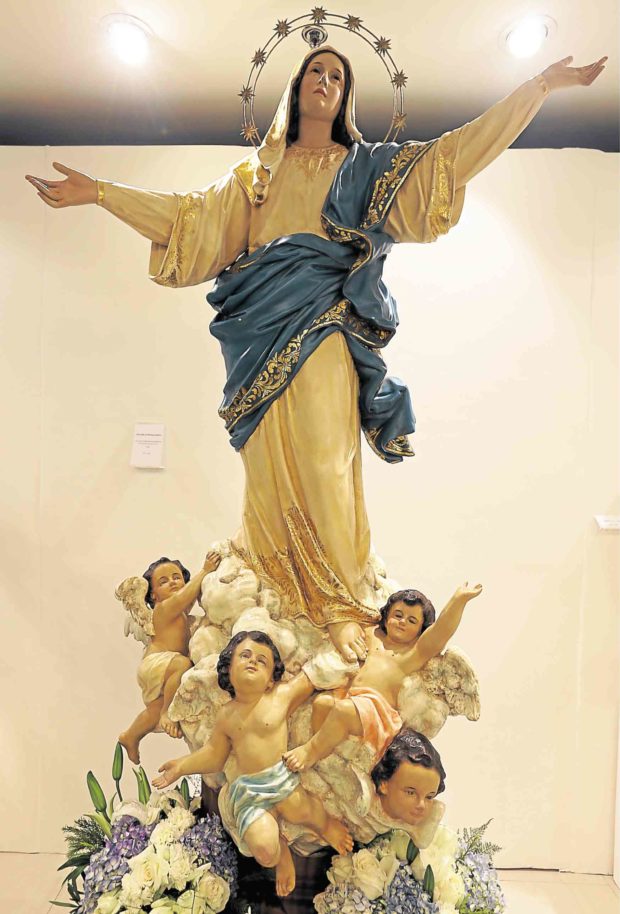
Regina “Renee” Vicente Francisco is wistful as she considers the prospect of parting with the last remnants of her grandfather’s legacy, 98 pieces of religious sculptures made at the Talleres de Maximo Vicente, the oldest workshop for religious iconography in the Philippines.
This must be the biggest exhibit-sale of Vicente sculptures in the country in recent years.
Francisco, 73, is the custodian of the samples of wood-carved icons from the Ermita, Manila, workshop, including one original by the master sculptor himself, a life-size Our Lady of the Assumption.
The collection was left in her care when her mother, Soledad Hernandez-Vicente, died in 2015. Soledad and her husband, Maximo Jr., ran the workshop after Maximo Sr. died in 1964. All the pieces are samples, and over 50 years old.
“I prayed and asked permission from my mother. I said I can’t keep them any longer. I’m almost 74,” Francisco says. She has a living brother but he lives in the United States. “I decided it was time to downsize.”
Exhibit-sale
Francisco approached her Assumption classmate, Rustan’s chair Zenaida Tantoco, who agreed to exhibit the collection at Rustan’s Makati (fifth floor). The exhibit opens on April 22 at 5 p.m. The collection will later be shown at Rustan’s Shangri-La Plaza, and perhaps even at Rustan’s Cebu.
All the pieces are for sale. The centerpiece, the Maximo Vicente original, is priced north of P3 million.
Vicente’s early start as a santero—an artisan who makes religious icons, or santos—is unclear. Francisco quotes Google and refers to the information from yellowed newspaper and magazine clippings when she talks about her grandfather.
She believes that Vicente was born to a single mother,
Antonina Vicente, and a Spaniard, in Malabon in 1885. The young Maximo stayed with an uncle who worked as forest ranger. It was during this time that he picked up woodcarving as a hobby.
Some accounts say he was self-taught, with no formal training in the craft. A bio printout Francisco provided us, however, says Vicente graduated from the “UP School of Fine Arts” in 1909 (though the University of the Philippines was founded only a year before, in 1908).
No matter these discrepancies, there’s no questioning Maximo Vicente Sr.’s legacy as a master sculptor and wood carver. He set up his workshop in 1908, first on Calle Hidalgo in Quiapo, with his half-brothers.
Statues made at the Talleres de Maximo Vicente live on in the homes of wealthy private collectors, as well as big churches, like San Beda Mendiola and San Beda Alabang, Our Lady of Mount Carmel in New Manila, Assumption Convent in San Lorenzo and St. Alphonsus de Liguori in Magallanes.
A Sto. Niño made by the taller was also given to Pope John Paul II, which was later installed at the Pontifico Collegio Filippino in Rome.
An Our Lady of the Barangay was also sent to Rome, says Francisco.
Many santos used for processions around the country are also likely from the Vicente taller, including the San Beda Mendiola Sto. Niño de Praga, which is brought out every January.
Sadly, the taller didn’t keep a catalog of its clients and the pieces they made.
On par with the best
Collectors say a Vicente piece—made mostly of baticulin wood—is on par with the best made by santeros in Europe.
“My mother (Glecy) collected his works and commissioned many pieces from the taller,” says Marilen Tantoco, Rustan’s vice president for home merchandising. “My sister Nedy is also a collector. There are other sculptors and workshops, but not as artistic as Maximo Vicente, according to my mother.”
Vicente had 11 children but only four survived, including Francisco’s dad, the only one who had children. None of the surviving heirs, however, learned the patriarch’s craft. Vicente’s only daughter, Victorina Laxamana Vicente, became a nun and founded the Sisters of the Holy Face of Jesus in Quiapo (a life-size Baby Jesus by Vicente is in the convent). Maximo Jr. himself became an architect.
“It stopped with my grandfather. Nobody picked it up, not even my generation. I think the craft is a gift. My parents, however, continued to run the workshop and we had workers who made the icons in the style of my grandfather,” Francisco says.
Their works were mostly made-to-order, and each took a month or two for turnaround.
These days, they do mostly restoration work. Any new commissions will be accepted only after Francisco’s six-month contract with Rustan’s ends. “We just don’t do the clothes of the santos anymore. That stopped with my mom.”
Francisco has made peace with her move, content with the few Maximo Vicente heirloom pieces in her personal collection—“a Sacred Heart, one Mama Mary and another Our Lady in a glass dome.”
“If there are people who want to have their own custom piece, we can do that still,” she says. “But all these need new homes,” she adds, referring to the collection to go on exhibit.